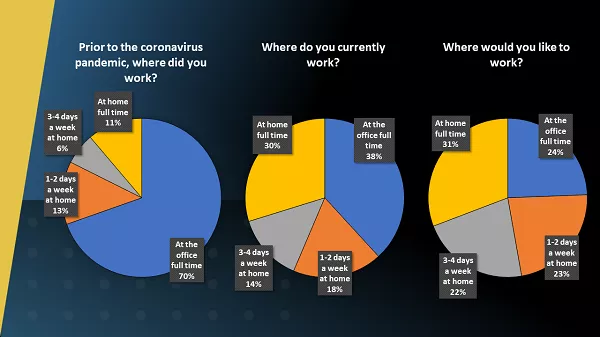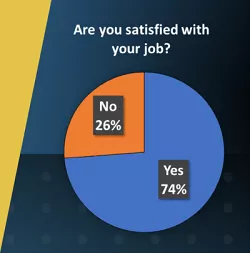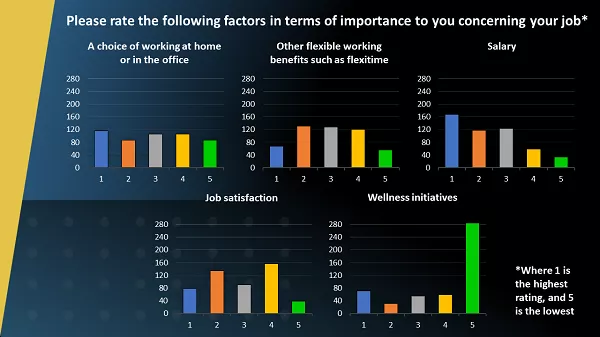Workforce Survey Report: 2021 State of the Workforce report
Written in
Following a survey of the UK workforce, Bodet presents its findings and analysis
Bodet recently conducted a survey of 500 full-time employees in the UK to see the effect of the coronavirus pandemic on the workforce, particularly regarding the split between home, hybrid and office working. We also wanted to measure job satisfaction levels, along with how important certain factors are to employees.

In the below article, we present our findings, along with some analysis to help organisations better understand the evolving workforce landscape and maintain productivity. It can also be downloaded in PDF format through the link at the bottom of the page.
Bodet’s 2021 State of the Workforce Survey Report
Introduction
There can be no doubt that the coronavirus pandemic has affected the way that most businesses operate. These changes have filtered down to the workforce, with the rise of flexible working and hybrid working split between home and the office. Whilst employers might think they understand this new employee perspective, it’s more crucial than ever for organisations not to make assumptions about their staff.
As leading Workforce Management Specialists, Bodet wanted to provide a snapshot of the UK workforce, looking at the situation both now and pre-pandemic. This in turn should enable employers to provide the best match of working practices where possible to what’s actually important to their workers.
By enabling employees to work how they want, you increase their productivity and engagement. Furthermore, elements such as homeworking can even equate to a real-terms salary increase if it reduces commuting, and promote wellness through a better work-life balance. Since the job market has now shifted in favour of the worker, this practice also increases the chances of your organisation retaining and hiring those who are more skilled.
We surveyed 500 UK full-time employees who are able to do their job in an office. The survey was conducted via survey platform provider Pollfish.
Results
As you might expect, pre-pandemic 70% of respondents who are able to work in an office were in that environment full-time, whereas just 11% worked at home five days a week. This paints a picture of a business landscape with flexible working still very much in its infancy as far as deployment is concerned.

Looking at the situation now, it’s no real surprise to see that the number of employees only working in the office has reduced to just 38%. Of that original 70%, now less than half still remain working in an office full time.
The feedback for desired working location suggests a more complex situation. With results being as evenly distributed as they are, they point to a critical factor in issues like flexible working: that employees should be consulted to take their preference into account. Whilst most would favour a hybrid approach split between home and the office, there are definitely those who prefer working at home full time, or even always working in the office. There is no ‘one-size-fits-all solution’, and employees should ideally be treated as individuals first and foremost.

In good news for the majority of organisations, almost three quarters of respondents are currently satisfied with their job. This position seems to be largely unaffected by any particular recorded factor. Perhaps of note is how job satisfaction seems to be affected by whether respondents are currently satisfied or not; those who answered positively rank it the second-most critical factor, whereas those who didn’t rank it second last.
Job importance factors are fairly well spread, similar to desired workplace locations. The only clear outlier is wellness initiatives, which perhaps suggests that even following a global pandemic, many workers don’t see any links between their personal health and their job. As might be expected, salary is the most popular factor, although not by a large amount.
The importance of working location seems noticeably linked to what the respondent’s location category actually is. For those ranking it the most important factor, almost 80% work at home in some capacity. This is compared to those ranking it least important, of whom 60% work only in the office, with three quarters preferring it. This potentially suggests that workers might only consider the importance of this kind of flexible working after experiencing it.

Conclusion
More than anything, the coronavirus pandemic has accelerated the shift towards hybrid and total homeworking. Even once the pandemic subsides, it is unlikely that we will see the same dominance of fully office-based roles that we once did, with even traditional financial institutions such as Deutsche Bank indicating a shift towards a hybrid model.
To many, this middle ground seems like the most convenient offering for both employers and employees. However, those organisations wanting to both retain and attract highly-skilled workers will need to consider a more tailored approach, matching specific flexible working practices to the needs of each individual. This consultative strategy ensures employees are aware of all the options, and is much more likely to lead to job satisfaction, further boosting productivity.
Bodet's Time & Attendance Systems
Bodet’s modern Time & Attendance Systems are specifically designed to help organisations offer a range of flexible working practices without losing workforce visibility or increasing HR administration.
Whether your staff work at home or in the office, a range of clocking in methods such as smartphones, PCs and wall-mounted terminals all collect attendance data in real time, with alerts for anomalies such as lateness or absences.
Cloud software enables you to access our solution on any web-enabled device, with a responsive dashboard which adapts depending on the device you use to access it and your user level.
Employees can be allocated as homeworkers, giving those shifts increased visibility on staff schedules, and enabling specific reporting, customised rules and a separate authorisation process.